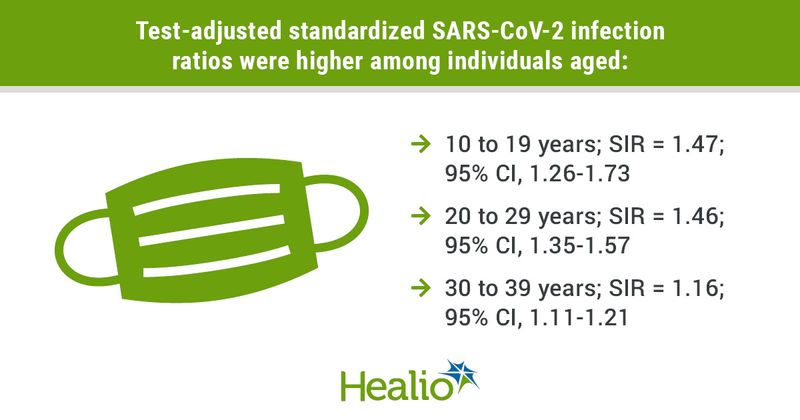SARS-CoV-2 infection rate 2.5 times higher in younger men, study shows
Younger individuals, particularly men aged 20 to 29 years, may be underrecognized, high-risk groups for SARS-CoV-2 infection, according to findings published in Annals of Internal Medicine.
The pandemic has been characterized by a higher incidence of COVID-19 in older adults and a lower incidence in younger populations; however, researchers hypothesized that this may be due to differences in testing frequency. After adjusting SARS-CoV-2 infection ratios in Canada for testing rates, the researchers reported finding “a different view of the epidemic than that seen with usual surveillance.”

“Our approach highlights the likely importance of younger persons, particularly younger males, as silent drivers of virulent infection in older adults,” David N. Fisman, MD, MPH, a professor in the division of epidemiology at the University of Toronto, and colleagues wrote. “Although the work presented here awaits validation in other settings, it provides a simple, inexpensive approach to more nuanced estimation of true infection risk by age.”
Fisman and colleagues conducted a population-based cohort study to determine the relationship between differential testing by age group and variation in SARS-CoV-2 infection. The analysis included information on 132,075 diagnosed cases of COVID-19 and 6,315,449 test results in Ontario, Canada, from March 1, 2020, to December 8, 2020. The researchers obtained test volumes, including testing and reporting dates, for all PCR tests from the Ontario Laboratories Information System. They linked daily case counts and test counts by gender and 10-year age category to report dates.
The analyses revealed that testing patterns were age-specific, with older adults having the highest testing rates during a “testing blitz” in long-term care facilities in mid-May, according to the researchers. During this time, there were up to 862 tests per 100,000 people aged 80 years or older. Overall, daily testing rates increased 20-fold from 12.5 tests per 100,000 people in March to 239 per 100,000 in September through the first week of December, according to Fisman and colleagues.
Men were less likely to be tested than women, but they had a higher per-test positivity rate, the researchers reported. Testing and observed disease incidence rates were lowest in individuals aged younger than 20 years and highest in individuals aged older than 80 years. While the crude cumulative incidence of infection was 80% higher among individuals aged 80 years or older, after adjusting for testing, their risk for infection was 50% lower than the overall population.
The test-adjusted standardized infection rates (SIRs) were lowest among children aged 9 years and younger (test-adjusted SIR = 0.59; 95% CI, 0.45-0.77), adults aged 70 to 79 years (test-adjusted SIR = 0.67; 95% CI, 0.62-0.73) and adults aged 80 years and older (test-adjusted SIR = 0.53; 95% CI, 0.45-0.62). The researchers observed higher infection rates in individuals aged 10 to 19 years (test-adjusted SIR = 1.47; 95% CI, 1.26-1.73), 20 to 29 years (test-adjusted SIR = 1.46; 95% CI, 1.35-1.57) and 30 to 39 years (test-adjusted SIR = 1.16; 95% CI, 1.11-1.21). The highest rate was among young men aged 20 to 29 years, who had a test-adjusted infection rate that was 2.5 times higher than the rate of the overall population.
“The observed epidemiology of reportable communicable diseases is often based exclusively on reports of test-positive cases without reference to how many people tested,” Fisman and colleagues wrote. “However, observed incidence depends on diagnostic testing, and differential testing volumes may dramatically alter how an epidemic is perceived.”
